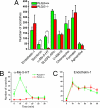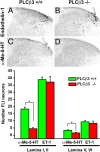TRPV1-expressing primary afferents generate behavioral responses to pruritogens via multiple mechanisms
- PMID: 19564617
- PMCID: PMC2708751
- DOI: 10.1073/pnas.0905605106
TRPV1-expressing primary afferents generate behavioral responses to pruritogens via multiple mechanisms
Abstract
The mechanisms that generate itch are poorly understood at both the molecular and cellular levels despite its clinical importance. To explore the peripheral neuronal mechanisms underlying itch, we assessed the behavioral responses (scratching) produced by s.c. injection of various pruritogens in PLCbeta3- or TRPV1-deficient mice. We provide evidence that at least 3 different molecular pathways contribute to the transduction of itch responses to different pruritogens: 1) histamine requires the function of both PLCbeta3 and the TRPV1 channel; 2) serotonin, or a selective agonist, alpha-methyl-serotonin (alpha-Me-5-HT), requires the presence of PLCbeta3 but not TRPV1, and 3) endothelin-1 (ET-1) does not require either PLCbeta3 or TRPV1. To determine whether the activity of these molecules is represented in a particular subpopulation of sensory neurons, we examined the behavioral consequences of selectively eliminating 2 nonoverlapping subsets of nociceptors. The genetic ablation of MrgprD(+) neurons that represent approximately 90% of cutaneous nonpeptidergic neurons did not affect the scratching responses to a number of pruritogens. In contrast, chemical ablation of the central branch of TRPV1(+) nociceptors led to a significant behavioral deficit for pruritogens, including alpha-Me-5-HT and ET-1, that is, the TRPV1-expressing nociceptor was required, whether or not TRPV1 itself was essential. Thus, TRPV1 neurons are equipped with multiple signaling mechanisms that respond to different pruritogens. Some of these require TRPV1 function; others use alternate signal transduction pathways.
Conflict of interest statement
The authors declare no conflict of interest.
Figures






References
-
- Ikoma A, Steinhoff M, Stander S, Yosipovitch G, Schmelz M. The neurobiogy of itch. Nat Rev Neurosci. 2006;7:535–547. - PubMed
-
- Twycross R, et al. Itch: Scratching more than the surface. Q J Med. 2003;96:7–26. - PubMed
-
- Schmelz M, et al. Chemical response pattern of different classes of C-nociceptors to pruritogens and algogens. J Neurophysiol. 2003;89:2441–2448. - PubMed
-
- Andrew D, Craig AD. Spinothalamic lamina I neurons selectively sensitive to histamine: A central neural pathway for itch. Nat Neurosci. 2001;4:72–77. - PubMed
Publication types
MeSH terms
Substances
Grants and funding
LinkOut - more resources
Full Text Sources
Other Literature Sources
Medical
Molecular Biology Databases
Research Materials

